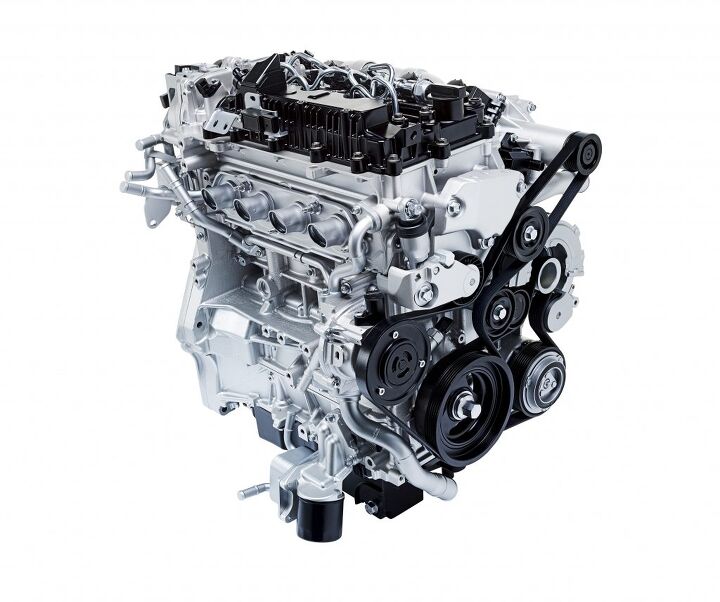#SKYACTIV-G
Mazda's U.S. Skyactiv-X Arrival Definitely Delayed
While other manufacturers are downsizing engines and sticking turbos anywhere they’ll fit, Mazda has attempted to maintain a home for naturally aspirated motors — engines it believes should be sized appropriately for their intended application. On paper, this appears to be giving the competition an edge. Yet Mazda remains committed to offering the right tool for the job, introducing naturally aspirated Skyactiv engines with unusually high compression ratios. The latest, Skyactiv-X, combines spark-controlled gasoline combustion and compression-ignition diesel tech with a 24-volt mild-hybrid system.
The system delivers 178 horsepower and 164 lb-ft of torque in 2.0-liter guise, plus MPG improvements of up to 20 percent vs the old Skyactiv-G. But there’s a problem. With Mazda attempting to go upmarket, an economy-focused powertrain has to deliver in whatever region it’s sold, and introductory Skyactiv-X units are now viewed as too small for the United States. The result? The technology’s delayed arrival in North America, despite its deployment via the new 2.0 liter found in the 2020 Mazda 3 and CX-30 sold in Japan and Europe.
Skyactiv-X Engine Debuts Inside 2019 Mazda 3 This Month
Mazda is bringing its new Skyactiv-X engine, hyped as a major leap forward in internal combustion engine technology, to the Los Angeles Auto Show and the end of the month. Wedged inside the new Mazda 3 sedan and hatchback, the powerplant uses “Spark Controlled Compression Ignition,” which is said to combine the efficiency of a diesel unit with the performance of a gasoline mill. The manufacturer claims fuel economy improvements of more than 30 percent over a standard gasoline engine of the same displacement.
Assuming Mazda meets that mark, it’s a petty impressive feat. The 2.0-liter four-cylinder will debut along with the 3’s new platform in L.A. at the end of the month.
2016 Mazda CX-3 Review - Nomenclature, Be Damned
2016 Mazda CX-3 Grand Touring AWD (U.S.)/GT AWD (Canada)
2.0-liter SKYACTIV DOHC I-4, direct injection, dual S-VT (146 horsepower @ 6,000 rpm; 146 lbs-ft of torque @ 2,800 rpm)
6-speed SKYACTIV-Drive automatic w/ Sport mode and paddle shifters
27 city/32 highway/29 combined (EPA Rating, MPG)
30 mpg on the camping-gear-laden test cycle, 80 percent highway (Observed, MPG)
Tested Options: i-ACTIVSENSE Safety Package (U.S.)/Technology Package (Canada), i-ACTIV all-wheel drive (U.S., AWD is standard on GT trim in Canada)
Base Price:
$20,840* (U.S.)/$22,680* (Canada)
As Tested Price:
$29,040* (U.S.)/$32,490* (Canada)
* All prices include $880 destination fee (U.S.) or $1,995 destination fee, PDI and A/C tax (Canada).
For as long as I can remember, my parents always had two vehicles while I was growing up. The first one I can vividly remember was the precursor to GM’s dreaded Cavalier and Cobalt, a 1987 Chevrolet Chevette, with an interior as roomy as any compact you can buy today. The second conveyance in our driveway was a 1992 Suzuki Sidekick, Jay Green in color, and rugged as my father needed for his job traversing Cape Breton Island’s vast spaghetti network of logging roads.
In the early 1990s, the Chevette ended with a bang. As I laid on a bed at my grandmother’s apartment, attempting as much as a young child would to get to sleep (translation: not trying at all), I was startled by tire squealing, a loud bang, silence, then more tire squealing. The Chevette had been dispatched by a freshly licensed 16-year-old driving a Hyundai Pony and fueled by Vitamin O. Write-off total: approximately $500 — for both cars.
The Chevette, now off to the scrapyard, was replaced by a Pontiac Firefly five-door, known for its economical three-cylinder engine outputting double-digit horsepower whilst solidly achieving double-digit miles per gallon halfway to the centripulcate. As a daily runabout, it was solid, economical, and — with its wagon-esque virtues — incredibly versatile.
Back then, my parents were about the same age I am now. They were the last of the Baby Boomers and in the 1990s faced what many Millennials face today. My parents were done with school and working on budding careers and a growing family inside their newly acquired home. There are some key differences between them and me however: I have one extra dog (for a total of two), lack children and I don’t own a home.It’s in this context that my girlfriend and I headed out on one of my family’s favorite pastimes from when I was a child — a weekend camping trip — in the millennial-focused 2016 Mazda CX-3.


















Recent Comments